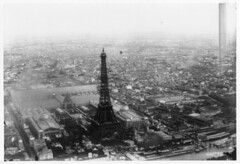The Eiffel Tower @120
The Eiffel Tower was inaugurated April 1, 1889 in Paris.
The Eiffel Tower is an iron tower in Paris, France. It is one of the tallest structures in Paris and one of the most recognized and visited monuments in the world. Named after its designer, engineer Gustave Eiffel, it stands as a symbol to the modernity of Nineteenth century Paris.
The tower was met with criticism from the public when it was built, with many calling it an eyesore. (Novelist Guy de Maupassant — who claimed to hate the tower — supposedly ate lunch at the Tower’s restaurant every day. When asked why, he answered that it was the one place in Paris where you couldn’t see the Tower.)
One of the great Hollywood movie clichés is that the view from a Parisian window always includes the tower. In reality, since zoning restrictions limit the height of most buildings in Paris to 7 stories, only a very few of the taller buildings have a clear view of the tower. The relationship Eiffel Tower/Paris is metonymical.
The Eiffel Tower was the second instance of modern architecture after the Crystal Palace, modern architecture understood to be driven by technological developments, a celebration of the aesthetics of iron, steel, concrete and glass.
Iron, steel, concrete and glass
I see modern architecture as primarily driven by technological and engineering developments, rather than artistic and social developments) and that the availability of new building materials such as iron, steel, concrete and glass drove the invention of new building techniques as part of the Industrial Revolution. The first example in this category is the Crystal Palace which used iron, steel, concrete and glass to house the Great Exhibition of 1851.
About 40 years later in France, the Eiffel Tower was inaugurated. It broke all previous limitations on how tall man-made objects could be—and at the same time offered a radically different environment in urban life.
The style was first verbally celebrated by futurist architect Antonio Sant’Elia in 1914 in his Manifesto of Futurist Architecture.
- “The house of concrete, glass and steel, stripped of paintings and sculpture, rich only in the innate beauty of its lines and relief, extraordinarily “ugly” in its mechanical simplicity, higher and wider according to need rather than the specifications of municipal laws. It must soar up on the brink of a tumultuous abyss: the street will no longer lie like a doormat at ground level, but will plunge many stories down into the earth, embracing the metropolitan traffic, and will be linked up for necessary interconnections by metal gangways and swift-moving pavements. ”


Thirty-Six Views of the Eiffel Tower by Henri Rivière is a great series of Hokusai-inspired renderings of the tower.
http://www.henri-riviere.org/v2/contenu/main.php?menu=16
Thanks for bringing these back to my attention, they are lovely, I believe I saw them first over at your blog.
The Eiffel Tower fascinated many modernist artists, notably Robert and Sonia Delaunay. Supposedly the print run of Blaise Cendrars’ prose poem La prose du Transsibérien, with wonderful pochoir illustrations by Sonia running up the length of the book (which opens up like a concertina) was determined by how many copies were needed to match the height of the Tower. Though actually I believe many fewer copies were printed.
Wow Neil, stupendous!
Thanks for that pointer.
http://en.wikipedia.org/wiki/La_prose_du_Transsib%C3%A9rien_et_de_la_Petite_Jehanne_de_France
The style was first verbally celebrated by futurist architect…
I must disagree. Saint Elia brought a sensibility to the architecture of steel and glass that we recognize as distinctly “modernist” but he was certainly not the first to sing its praises or to design buildings in that style. (Actually, I don’t know if he ever built anything at all!) The second half of the 19th century is filled with architects and engineers giddy with the power these new materials gave them, and eager to struggle with the process of coming up with a new architecture to match them. The skyscraper designers of 19th century Chicago come to mind…
Yes, I see,
I probably did not express myself accurately.
He is the first to celebrate the cult of ugliness in architecture:
…extraordinarily “ugly” in its mechanical simplicity…
and he also celebrated Centre Pompidou aesthetics:
…The lifts must no longer be hidden away like tapeworms in the niches of stairwells
I’m pretty sure none of the Chicago architects did this.
True, he was an artist rather than an architect:
Visionary architecture or “paper architecture” is the name given to architecture which exists only on paper or which has visionary qualities. Étienne-Louis Boullée, Claude Nicolas Ledoux and Jean-Jacques Lequeu are one of the earliest examples of the discipline. But the work of Giovanni Battista Piranesi, Antonio Sant’Elia and Buckminster Fuller is also included. In the latter half of the 20th century, there were architectural design movements such as Archigram, Archizoom and Superstudio.
The architectural paintings of Giorgio de Chirico also are sometimes included in this category.
wHAT WAS THE NAME OF THE RESTAURANT ON 2ND LEVEL OF eIFFEL tOWER IN YEAR 1954 ???